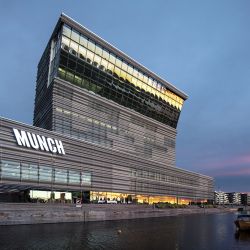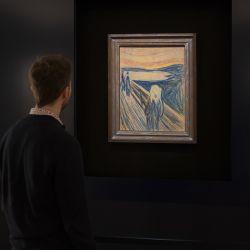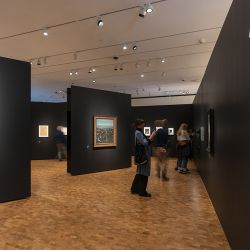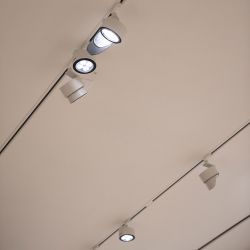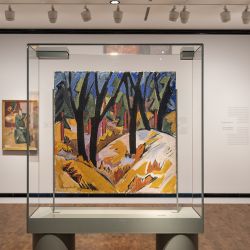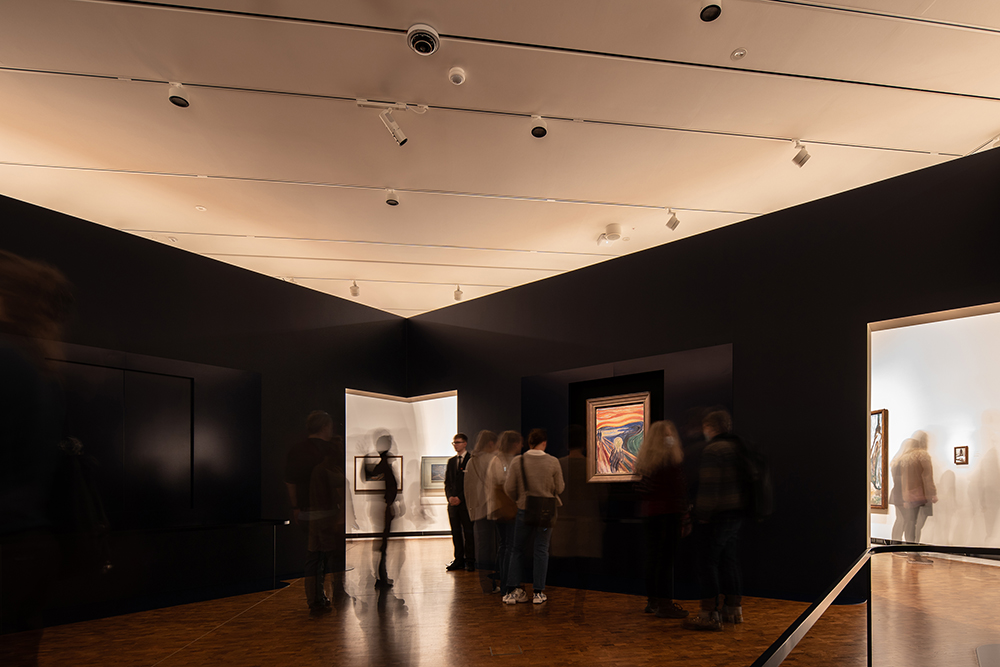
Download this article:
A striking new waterfront museum, dedicated to the world's largest collection of works by Norwegian artist Edvard Munch, has opened in his birthplace of Oslo. Considered one of the key Symbolist painters of the 20th century, Munch's painting The Scream is one of the most iconic images in world art. The landmark 60m-high tower by Spanish architect Juan Herreros has 13 floors and 11 gallery spaces which allow for wide variations in ceiling heights and room sizes. The artistic flexibility this enables called for a highly versatile lighting system that could address the widely varying requirements of individual exhibits and spaces.
Perfectly adapted light
In a lighting scheme by Oslo-based lighting consultant Zenisk, the artworks are almost entirely lit by ERCO's universal spotlight system Parscan. Specially developed for museums, the system features multiple sizes, optical accessories and nine different interchangeable light distributions which can be adapted without use of tools.
This allowed Zenisk to design for the individual needs of the exhibits as well as enabling luminaires to be easily rearranged for both temporary and permanent exhibition layouts. There are different display methods for the various types of artwork, ranging from wall-hung large paintings without glass, to paintings framed with glass, and horizontally mounted works in cabinets.
Around 2,500 DALI-controlled Parscan fittings were installed in various wattages—12W, 24W or 48W—and with a whole range of beam widths and accessories, which also ensured optimum visual comfort for visitors. 'We used the full range of ERCO's Parscan series to adapt the light perfectly to each work and each exhibition situation,' says Zenisk Chief Designer Kristin Bredal.
Static and dynamic
The organization of the building into two zones—static and dynamic—also had an impact on the approach to the lighting. The static zone houses the art and, among other protective measures, has no daylight. The dynamic zone is more open and features generous glazing to feature the views of Oslo.
Visitors enter exhibition rooms from daylit areas into closed, artificially lit spaces. This entailed extensive discussions about adaptation time from daylight to the low light levels that the art required. Zenisk wanted to design the light in such a way that visitors wouldn't register the artificial room lighting but rather experience spaces as naturally lit with intuitive orientation.
'We wanted the artwork to appear naturally illuminated without visible, emphasized focus, and of course without reflections and glare,' says Bredal. 'It was an important principle for the museum and for us that the exhibition halls should be experienced as bright and comfortable to be in, not be perceived as dark with artworks appearing as icons.
'It was also important to bring out the pure colors and the glow in Munch's paintings, drawings and prints,' she adds. 'Therefore, great emphasis was put on light quality, color rendering, distribution and angle of light.'
A warm white 3000K color temperature is used throughout. Excellent color rendering was essential. 'The crucial feature is color rendition and there is no doubt that ERCO delivers an exceptional quality for this purpose,' says Bredal. 'And of course, we value qualities such as smoothness in distribution, and practical features such as easy replacement of optics.'
'Mona Lisa for our times'
The centrepiece of the exhibition is inevitably The Scream, described by the American journalist and art critic Arthur Lubow as the 'Mona Lisa for our times'. More accurately, three versions of the artwork that Munch created are featured, mounted in cabinets that are alternately open during the day due to their fragility and sensitivity to light exposure. The room is completely dark with cabinets painted black.
The works are illuminated to just 2.32fc with precisely adapted framing using ERCO's Eclipse spotlights. 'This gives a feel that the artwork emerges from the dark,' says Bredal. 'The quality and natural color rendering with dimmed light needed to be perfect all the way down to 2.32fc. The rest of the exhibition had to be lit in such a way that this main work does not appear dim in comparison.' Eclipse works in the most effective way: High illuminance on the target surface despite low connected load. Light is only where it’s needed, without spill light thanks to precise, dedicated optical systems. A perfect example of sustainable lighting focusing on perception-orientated lighting.
The collection, bequeathed by Munch to the Norwegian government on his death in 1944, comprises more than 26,700 works, including around 1,200 paintings and over 42,000 museum objects ‘The individuality of the artworks, their visibility, the narratives in their curation, and how the room and the organization of exhibits were perceived were all factors that needed to be reconciled’, says Bredal.
'How the light is distributed and balanced is really where our profession can bring added value to the experience. It is often subtle but means a lot.'
Project data
Client: Munch Museum, Oslo / Norway
Architecture: estudioHerreros, Madrid / Spain
Lighting Design: ZENISK, Oslo / Norway
Photography: Tomasz Majewski, Oslo / Norway
Products: Parscan, Eclipse InTrack
Photo credits: © ERCO GmbH, www.erco.com,
Fotografie: Tomasz Majewski
About ERCO
The ERCO Light Factory in the German town of Lüdenscheid is a leading international specialist in architectural lighting using LED technology. The family business, founded in 1934, now operates as a global player with independent sales organisations and partners in 55 countries worldwide. Since 2015, ERCO’s portfolio has been 100% LED. With this in mind, ERCO in Lüdenscheid develops, designs and produces digital luminaires with focus on photometrics, electronics and design. Working closely with architects, lighting designers and engineers, ERCO develops lighting tools used primarily for applications in the following fields: Work and Culture, Community and Public/Outdoor, Contemplation, Living, Shop and Hospitality. ERCO understands digital light as the fourth dimension of architecture – providing highly precise and efficient lighting solutions to support creative designers in turning their visions into reality.
If you require any further information on ERCO or image material, please visit us at press.erco.com/en. We can also provide you with material on projects worldwide for your media coverage.
Relevant image material
©ERCO GmbH, www.erco.com, photography: Tomasz Majewski
©ERCO GmbH, www.erco.com, photography: Tomasz Majewski
©ERCO GmbH, www.erco.com, photography: Tomasz Majewski
©ERCO GmbH, www.erco.com, photography: Tomasz Majewski
©ERCO GmbH, www.erco.com, photography: Tomasz Majewski
©ERCO GmbH, www.erco.com, photography: Tomasz Majewski
